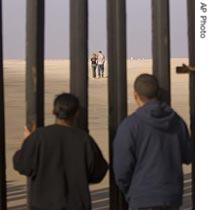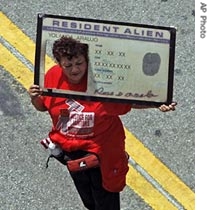VOA慢速英语 2008 0310b
搜索关注在线英语听力室公众号:tingroom,领取免费英语资料大礼包。
(单词翻译)
THIS IS AMERICA - With All the Talk About Illegal Immigration, a Look at the Legal Kind
Second of two programs on immigration issues in the US examines the rules for seeking permanent residency. Transcript1 of radio broadcast:
09 March 2008
Welcome to THIS IS AMERICA in VOA Special English. I’m Faith Lapidus.
VOICE TWO:
And I’m Steve Ember. Today we have the second of two programs on the issue of immigration in America.
(MUSIC)
VOICE ONE:
An estimated eleven million or more people are living in the United States illegally. What to do about them is at the heart of the debate over immigration reform. Yet questions about legal immigrants also remain unanswered.
For example, should the United States open its doors to more skilled workers? Many employers would like that. Or should Congress lower the current limits, to get employers to hire more American citizens? Or would that only lead them to move more jobs to other countries.
What about a temporary worker program, as President Bush proposed?
Or what about welcoming more skilled workers but fewer less educated immigrants? Or would that be seen as unfair in the land of the American dream?
VOICE TWO:
Congress tried to pass an immigration reform bill last year. But the Senate was unable to reach agreement. So, in place of legislative2 action, the administration announced new measures to increase border security and immigration enforcement. The steps include more workplace raids to catch illegal immigrants and higher civil fines for their employers.
Immigrant rights activists4 say stronger enforcement makes even legal immigrants fearful of being treated with suspicion. But activists against illegal immigration say providing for millions of people has a huge cost for public services. An activist3 in California says that state could be using the money to work on bridges and other public structures at risk from earthquakes.
VOICE ONE:
 |
| Two men watch from the Mexican side of the border wall in Tijuana |
In two thousand six, Congress passed the Secure Fence Act to build hundreds of kilometers of additional fencing along the southern border. The reasoning goes that secure borders with Mexico and Canada will help keep out illegal immigrants as well as drugs and terrorists.
But securing thousands of kilometers of borderline is easier said than done. A high-tech5 "virtual fence" using sensors6, cameras and radar7 systems has met with technical problems in a test project in Arizona.
(MUSIC)
VOICE TWO:
We talked a lot last week about illegal immigration. But how can someone legally move to the United States? Listeners often ask this question. There are five ways to become a permanent resident. But the process can be difficult and involve much waiting.
VOICE ONE:
 |
| A protester in Los Angeles shows a sign that looks like a United States green card |
A permanent resident is a foreign-born person who has most of the same rights as an American citizen. Permanent residents can work but they cannot vote or hold political office. They can also face expulsion in addition to any other punishment if they are found guilty of a serious crime.
Proof of permanent residency is a small identification card commonly known as a green card. The current color is light red. But the card was green once and the name stuck.
Green cards come from United States Citizenship8 and Immigration Services, an agency in the Department of Homeland Security.
VOICE TWO:
Christopher Bentley is an agency spokesman. He says most people immigrate9 to the United States these days through family sponsorship. This means that a family member already in the United States takes responsibility for the immigrant.
Sponsors must be United States citizens or permanent residents. In addition, they must be at least eighteen years old and a blood relation of the person seeking residency.
VOICE ONE:
Chris Bentley says immediate10 relatives can immigrate without waiting. Immediate relatives include parents and unmarried children under the age of twenty-one. Other relatives can also come to the United States but they must wait for their visas. This can take, in some cases, as long as twelve to fifteen years.
People who marry American citizens are also immediate relatives. But they receive a conditional11 green card at first. It can be made permanent after two years if investigators12 are satisfied that the marriage was not just for immigration purposes.
VOICE TWO:
Sponsors must meet financial requirements and accept responsibility for the immigrants they are sponsoring. This financial responsibility continues until the immigrant becomes a citizen, or works in the United States for about ten years or moves away.
The Department of Homeland Security says one million two hundred thousand people received permanent residency in two thousand six. More than sixty percent of them became permanent residents as a result of a family relationship.
VOICE ONE:
Another way to gain permanent residency is to have a job offer, also called an employment-based preference. About one hundred sixty thousand people became permanent residents this way in two thousand six.
Often the employers are technology companies. But Chris Bentley gives an example of a sheep ranch13 in Texas. The employer found a really good shepherd. It was easier to sponsor him for residency than to continually bring him to the United States to help on the ranch.
(MUSIC)
VOICE TWO:
A third way to immigrate to the United States is to be declared a refugee. This immigration status is for people who fear physical harm if they remain in their home country. They have to go to an American Embassy and provide proof of their situation, or be referred by the United Nations refugee agency.
Foreign citizens who are in the United States as students or visitors can ask to stay if returning home would endanger their lives. People who are given asylum14 are called asylees. Two hundred sixteen thousand refugees and asylees became permanent residents in two thousand six.
VOICE ONE:
A fourth way to immigrate is to invest money in the United States. A person must invest at least five hundred thousand dollars in a poor area of the country and create at least ten jobs. Seven hundred fifty investors15 became permanent residents in two thousand six.
VOICE TWO:
The fifth and final way to immigrate to the United States is through the Diversity Immigrant Visa Program, also known as the visa lottery16. People enter the lottery and hope their name will be chosen by a computer.
The winners, their spouses17 and unmarried children under the age of twenty-one get a chance for permanent residency. The United States offers about fifty-five thousand diversity visas every year. In two thousand six, more than forty-four thousand winners became permanent residents.
VOICE ONE:
Congress established the program under a nineteen ninety immigration law. But the process is not as simple as it might sound. The program is open only to people born in countries with low rates of immigration to the United States.
These countries must have sent fewer than fifty thousand immigrants in the past five years. So the countries in the program change each year.
VOICE TWO:
The State Department received more than six million applications in two thousand six, about one million higher than the year before. The people who applied18 in two thousand six were entering the two thousand eight visa program.
Most of the applicants19 were from Africa and Asia. Nineteen percent were from Europe and two percent from South America and the Caribbean. The largest numbers of applications came from Bangladesh, Nigeria and Ukraine.
VOICE ONE:
All of the information needed to take part in the Diversity Immigrant Visa Program is online at travel.state.gov.
There are warnings about attempts to cheat people in connection with the visa lottery. In some cases there have been Web sites falsely claiming to be official United States government sites.
Some companies claiming to be from the government have asked for money to complete lottery entries. There is no charge to download and complete the electronic entry form.
VOICE TWO:
No paper entries are accepted. All applications must be made at travel.state.gov. The application period is from early October through early December of each year. That is the only time people can enter.
(MUSIC)
VOICE ONE:
Our program was written by Nancy Steinbach and produced by Caty Weaver20. I’m Faith Lapidus.
VOICE TWO:
And I’m Steve Ember. To learn more about the immigration issue, and for transcripts21, MP3s and podcasts of our programs, go to voaspecialenglish.com. Join us again next week for THIS IS AMERICA in VOA Special English.
 收听单词发音
收听单词发音 




